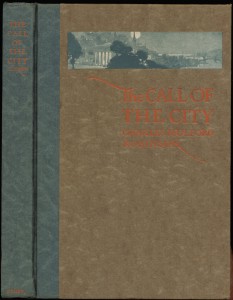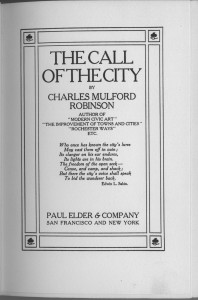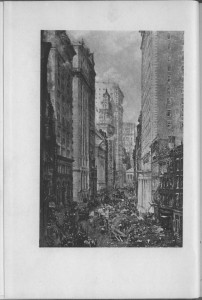
What was urban life like 100 years ago? The technology we now take for granted was either absent or in its infancy: electricity, automobiles, telephones, radio, television. In my own mind I picture New York City or Chicago with its teeming immigrants, and still manage to conclude that urban life was much like it is now: huge numbers of people all trying to get ahead in the world.
Among the important social facts of urban life then: city dwellers were a minority. In 1908, 56% of Americans still lived in rural areas (by 1920 the urbanites were in the majority, and in 2008 only 17% of Americans were rural). Today we tend to think of city vs suburb, but in 1908 the distinction was city vs farm.
The Call of the City, Charles Mulford Robinson’s tribute to urbanity, is an unabashed love-fest of the creature comforts that civilization can offer. Robinson is careful never to directly insult the farmer. Instead, he compares the city man to the outdoorsman:

If now and then, on a wet day, the city does not seem attractive, one should draw up before his fire and read the journal of a lover of the country, of a hunter of a fisherman in his wilds. The writer will early tell how shabbily the weather treated him, and it is a safe guess that one will not be so saintly as not to smile when thinking of a contrast offered by the safe harbor of a city. … The journal rambles on, and before it is done with the weather one may be sure of a page or so on the delicious difficulty in making a fire; on the remarkable failure of this particular fire, when built, to warm both sides of the body at the same time equally; and of the early darkness and the consequent and admittedly, long and tiresome evenings when the weather is rainy. If you are human, you shift your feet on the ottoman and ring for William to turn on the steam heat.
(Lucky for our city dweller that he has a manservant named William!)
Charles Mulford Robinson (1869–1917) was one of the first urban planners and an advocate of the City Beautiful movement. He was Professor of Civic Design at the University of Illinois at Urbana-Champaign, and wrote the influential 1901 book The Improvement of Towns and Cities.

My favorite chapter in the book is entitled “When Phyllis is in town”:
When Phyllis is in town the city is no longer austere and dignified. It becomes bewitching. Love is always full of sweet surprises, but at this time one may chance on a surprise at any moment and at any turn—for Phyllis may be there! … When Phyllis is in town, the windows of the florists tug at heart-strings and at purse-strings; the confectioners’ tempting trays plead sweetly for the little mouth; the windows of the milliners unaccustomedly attract, for in them are plumes, of which one may get on Phyllis’s hat … When Phyllis is in town, the music of her voice is in every tingle of the telephone, because—perhaps—she asked that it should ring … When Phyllis is in town, the world is such a great big funny spectacle for you and her to look at laugh at; and when she goes, it is such a dreary, solemn drama!